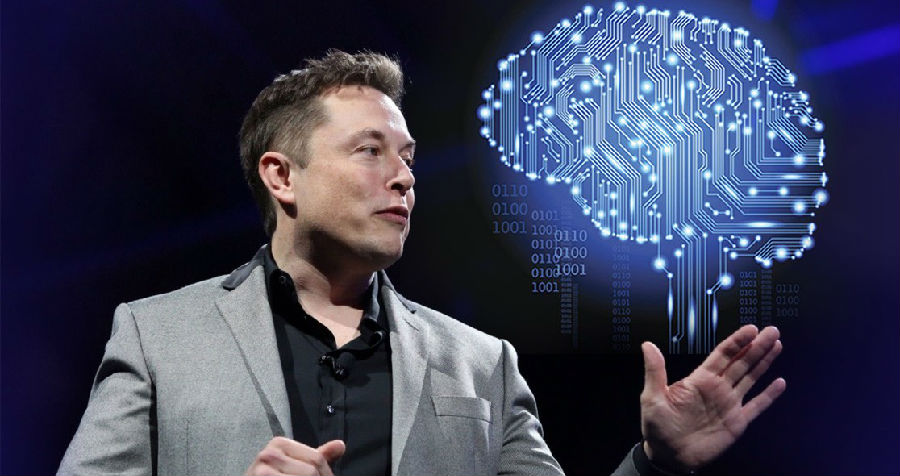Elon Musk, perhaps the world's most famous entrepreneur,
埃隆·馬斯克也許是世界上最著名的企業家,
is sometimes referred to as "the Trump of technology"— not for political reasons,
有時他被稱為是“技術界的特朗普”—并非出于政治原因,
but because of his habit of making, at short notice, spectacular pronouncements that stretch the bounds of credibility.
而是因為他習慣于在短時間內發表引人注目且超出可信度的聲明。
On July 16th he was at it again, unveiling a new type of brain-machine interface (BMI).
7月16日,他再次博人眼球,推出了一種新型的腦機接口(BMI)。
If human beings do not enter a symbiosis with artificial intelligence (AI), he declared, they are sure to be left behind.
他宣稱,如果人類不與人工智能(AI)建立共生關系,他們肯定會被甩在后面。
And he, the announcement implied, was going to be the man who stopped that happening.
并且聲明暗示,他將是阻止這一切發生的人。
Connecting brains directly to machines is a long-standing aspiration. And it is already happening, albeit in a crude way.
將大腦直接連接到機器上是一個長存的愿望。這已經在發生了,雖然是以一種粗糙的方式。
In deep-brain stimulation, for example, neurosurgeons implant a few electrodes into a patient's brain in order to treat Parkinson's disease.
例如,在深部腦刺激中,為了治療帕金森氏癥,神經外科醫生在病人的大腦中植入一些電極。
Utah arrays, collections of 100 conductive silicon needles, are now employed experimentally to record brain waves.
猶他陣列由100根導電硅針組成,目前已被用于記錄腦電波的實驗。

A team at the University of Washington has built a "brain-to-brain network"
華盛頓大學的一個團隊已經建立了一個“腦對腦網絡”
that allows people to play games with each other using just their thoughts.
可以讓人們利用自己的思維和對方玩游戲。
And researchers at the University of California, San Francisco, have captured neural signals from people as they talk,
舊金山加利福尼亞大學的研究人員捕捉到了人們說話時的神經信號
and have then turned that information, via a computer, into intelligible speech.
然后通過電腦將這一信息轉化成可理解的語言。
As with all things Musk-related, Neuralink is much more ambitious. The firm does not just want to develop a better BMI.
和所有與馬克斯相關的事物一樣,Neuralink的野心要大得多。該公司不僅僅想開發一個更好的BMI。
Its aim is to create a "neural lace", a mesh of ultra-thin electrodes that capture as much information from the brain as possible.
其目標是創造一個“神經蕾絲”,一種極薄的電極網,它能從大腦中捕捉盡可能多的信息。
Unsurprisingly, hurdles abound. The electrodes needed to do this must be flexible,
不出所料,障礙大量存在。這樣做所需要的電極必須是靈活的,
so that they do not damage brain tissue and will also last for a long time.
這樣才不會損壞腦組織并且還能持續很長一段時間。
They have to number at least in the thousands, to provide sufficient bandwidth.
為了提供足夠的帶寬,它們必須至少以數千計。
And to make the implantation of so many electrodes safe, painless and effective, the process has to be automated,
為了安全、無痛且有效植入這么多的電極,這個過程必須是自動化的,
much like LASIK surgery, which uses lasers to correct eyesight.
這很像是激光眼角膜手術,利用激光矯正視力。
Neuralink does indeed seem to have made progress towards these goals.
Neuralink似乎確實在實現這些目標方面取得了進展。
Its presentation, at the California Academy of Sciences, in San Francisco,
在舊金山的加利福尼亞科學院,其演講展示中
included videos of a neurosurgical robot that is best described as a sewing machine.
包含了一個神經外科機器人(最好形容為一臺縫紉機)的視頻。
This robot grabs "threads" (films, containing electrodes, that measure less than a quarter of the diameter of a human hair),
這個機器人抓取“線”(包含電極的薄膜,尺寸不到人類頭發直徑的四分之一),
and shoots them deep into the brain through a hole in the skull. It is capable of inserting six threads, each carrying 32 electrodes, per minute.
并通過頭骨上的一個洞把它們射入大腦深處。它每分鐘能夠插入六根線,每根線攜帶32個電極。
譯文由可可原創,僅供學習交流使用,未經許可請勿轉載。



